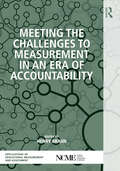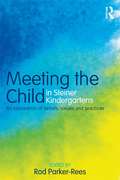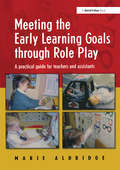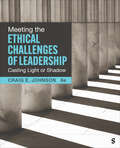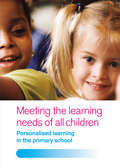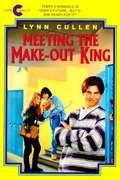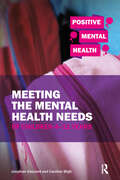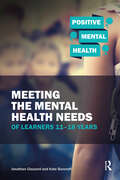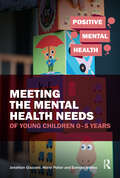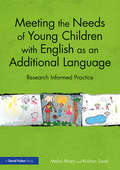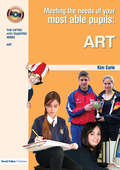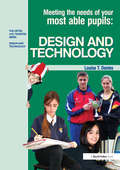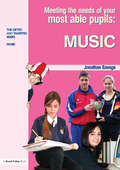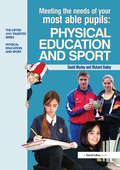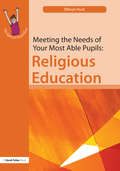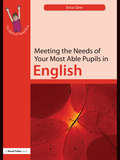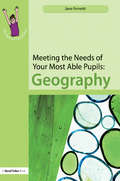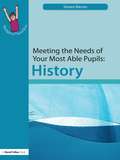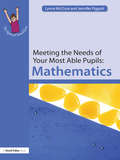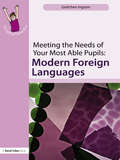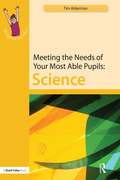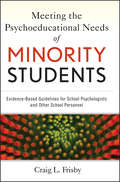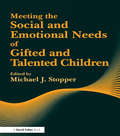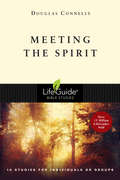- Table View
- List View
Meeting the Challenges to Measurement in an Era of Accountability
by Henry BraunUnder pressure and support from the federal government, states have increasingly turned to indicators based on student test scores to evaluate teachers and schools, as well as students themselves. The focus thus far has been on test scores in those subject areas where there is a sequence of consecutive tests, such as in mathematics or English/language arts with a focus on grades 4-8. Teachers in these subject areas, however, constitute less than thirty percent of the teacher workforce in a district. Comparatively little has been written about the measurement of achievement in the other grades and subjects. This volume seeks to remedy this imbalance by focusing on the assessment of student achievement in a broad range of grade levels and subject areas, with particular attention to their use in the evaluation of teachers and schools in all. It addresses traditional end-of-course tests, as well as alternative measures such as portfolios, exhibitions, and student learning objectives. In each case, issues related to design and development, psychometric considerations, and validity challenges are covered from both a generic and a content-specific perspective. The NCME Applications of Educational Measurement and Assessment series includes edited volumes designed to inform research-based applications of educational measurement and assessment. Edited by leading experts, these books are comprehensive and practical resources on the latest developments in the field. The NCME series editorial board is comprised of Michael J. Kolen, Chair; Robert L. Brennan; Wayne Camara; Edward H. Haertel; Suzanne Lane; and Rebecca Zwick.
Meeting the Child in Steiner Kindergartens: An Exploration of Beliefs, Values and Practices
by Rod Parker-ReesWhat can early years practitioners learn from Steiner kindergartens? What is distinctive about Steiner kindergarten teachers’ ways of getting to know children? As demands for accountability in Early Years settings continue to grow, external pressure to assess children and to measure their progress can disrupt the development of informal and intimate relationships between teachers and children. The contributors to this book, who include both experienced Steiner educators and early childhood experts from other backgrounds, have worked together to explore and understand what is distinctive about Steiner kindergarten practice. They present a variety of perspectives on the ways in which kindergarten teachers’ practices, values and beliefs can help children to find and construct their own identities, through play and through engagement in the life of their community. The authors explore key aspects of Steiner kindergarten practice, including caring for the physical environment, establishing rhythms and routines for children’s activity, and providing times and spaces in which teachers and children can get to know each other. By meeting with children and teachers, through rich accounts of day to day life in kindergartens and through accounts of the values and principles which inform their practice, readers will be encouraged to question and reflect on their own approaches to observation and assessment.
Meeting the Early Learning Goals Through Role Play: A Practical Guide for Teachers and Assistants
by Marie AldridgeThis book offers step-by-step guidance to help busy practitioners create meaningful role play that will delight young children, enhance learning and link to the Early Learning Goals. The role play scenarios have been carefully created so that children can identify with them and will be excited and eager to join in. They give children the opportunity to play freely, to discover and develop at their own pace and to link directly to the Early Learning Goals and beyond. This Book shows practitioners exactly how to plan, organize and implement role play activities. The activities have been tried, tested and enjoyed in the busy nursery where the author works. The book also divides the play scenarios into the DfES stated area of learning (personal, social, emotional, communication, language and literacy, mathematical, knowledge of the world, creative and physical) allowing practitioners to choose activities to suit their needs. The book includes: step-by-step guidance; photographs and plans; a list of easily obtained and inexpensive play equipment; and a planning template for practitioners to develop their own ideas. It should prove useful to teachers and assistants from nursery classes up to key stage 1.
Meeting the Ethical Challenges of Leadership: Casting Light or Shadow
by Craig E. JohnsonEthics is at the heart of leadership. Leaders must make every effort to make ethical decisions and foster ethical behavior among followers. The seventh edition of Meeting the Ethical Challenges of Leadership: Casting Light or Shadow 8th edition explores the ethical demands of leadership and the dark side of leadership. Bestselling author Craig E. Johnson takes an interdisciplinary approach, drawing from many fields of research to help readers make ethical decisions, lead with integrity, and create an ethical culture. Packed with dozens of real-world case studies, examples, self-assessments, and applications, this fully-updated new edition is designed to increase students’ ethical competence and leadership abilities.
Meeting the Ethical Challenges of Leadership: Casting Light or Shadow
by Craig E. JohnsonEthics is at the heart of leadership. Leaders must make every effort to make ethical decisions and foster ethical behavior among followers. The seventh edition of Meeting the Ethical Challenges of Leadership: Casting Light or Shadow 8th edition explores the ethical demands of leadership and the dark side of leadership. Bestselling author Craig E. Johnson takes an interdisciplinary approach, drawing from many fields of research to help readers make ethical decisions, lead with integrity, and create an ethical culture. Packed with dozens of real-world case studies, examples, self-assessments, and applications, this fully-updated new edition is designed to increase students’ ethical competence and leadership abilities.
Meeting the Learning Needs of All Children: Personalised Learning in the Primary School
by Joan DeanPersonalized learning involves helping each child to reach his or her full potential - intellectually, personally and socially. To achieve this, teachers need to match learning opportunities to the learning styles and experiences of the children, taking into account individual differences in culture, language, background, ability and interests.For
Meeting the Make-Out King
by Lynn CullenSeventh-grader Nora's happiness at being accepted into the cool crowd at school turns to discomfort when Dawn tries to match her up with Mark the make-out king.
Meeting the Mental Health Needs of Children 4-11 Years (Positive Mental Health)
by Jonathan Glazzard Caroline BlighHelps teachers to identify and support primary-aged children with mental health needs, providing a range of evidence-based tools. The mental health and well-being of children in primary schools is a current concern. Do you feel equipped to identify mental health needs in your pupils? Do you have the knowledge and understanding to adequately support them? Do you understand where your responsibilities start and stop? This book helps you address these questions and more, providing a range ofevidence-based strategies and tools. It introduces the various risk factorsinvolved, shows how you can build resilience in children, and focuses on identifying and supporting both specific mental health needs and particular groups of pupils.
Meeting the Mental Health Needs of Learners 11-18 Years (Positive Mental Health)
by Jonathan Glazzard Kate BancroftThe mental health of young people in secondary schools is a current concern. Do you feel equipped to identify mental health needs in your learners? Do you have the knowledge and understanding to adequately support them? Do you understand where your responsibilities start and stop? This book helps you address these questions and more, providing a range ofevidence-based strategies and tools. It introduces the various risk factorsinvolved, shows how you can build resilience in your students, and focuseson identifying and supporting both specific mental health needs and particulargroups of learners.
Meeting the Mental Health Needs of Young Children 0-5 Years (Positive Mental Health)
by Samuel Stones Marie PotterThe mental health of children is a current concern, and this applies even to the earliest years of a child’s life. This book supports trainees and practitioners working in early years contexts to understand the risk factors which can result in the development of mental health needs in children from birth to 5. It argues that high quality early years provision can mitigate against some of these risk factors and provides clear, evidence-informed guidance around government policy, transitions, attachment and working with parents or carers.
Meeting the Needs of Young Children with English as an Additional Language: Research Informed Practice
by Malini Mistry Krishan SoodDrawing on the latest research into how young children learn, this book considers how early years practitioners can best meet the needs of children with English as an Additional Language. It examines the factors that influence children’s learning including parents and the family, the environment, health and well-being, curriculum, play and relationships and aims to challenge misconceptions, assumptions and stereotypes. Featuring case studies and reflective questions, the chapters explore a range of important topics including: Language learning for children with EAL The historical concept and modern reconceptualisation of EAL How to develop and use Culturally Appropriate Pedagogy Regulation and performativity and their implications for children with EAL Leading learning for children with EAL Meeting the Needs of Young Children with English as an Additional Language is essential reading for students and practitioners wanting to promote an inclusive culture where different languages, cultures and religions are accepted and celebrated.
Meeting the Needs of Your Most Able Pupils in Art (The\gifted And Talented Ser.)
by Kim EarleMeeting the Needs of Your Most Able Students in Art provides specific guidance on: Recognising high ability and multiple intelligences Planning, differentiation and extension/enrichment in Art Teacher questioning skills Support for more able pupils with learning difficulties Homework Recording and assessment Beyond the classroom: visits, residentials, competitions, summer schools, masterclasses, links with other institutions. The book features comprehensive appendices and an accompanying CD with: Useful contacts and resources Lesson plans Liaison sheets for Teaching Assistants Homework activities Monitoring sheets For secondary teachers, subject heads of departments, Gifted and Talented co-ordinators, SENCos and LEA advisers.
Meeting the Needs of Your Most Able Pupils in Design and Technology (The Gifted and Talented Series)
by Louise DaviesMeeting the Needs of Your Most Able Pupils in Design and Technology provides specific guidance on: recognizing high ability and multiple intelligences planning, differentiation and extension/enrichment in D&T teacher questioning skills support for more able pupils with learning difficulties (dyslexia, ADHD, sensory impairment) homework recording and assessment beyond the classroom: visits, residentials, competitions, summer schools, masterclasses, link with universities, businesses and other organisations. The book features comprehensive appendices and an accompanying CD with: useful contacts and resources, lesson plans, liaison sheets for Teaching Assistants, homework activities and monitoring sheets. For secondary teachers, subject heads of departments, Gifted and Talented co-ordinators, SENCos and LEA advisers.
Meeting the Needs of Your Most Able Pupils in Music (The Gifted and Talented Series)
by Jonathan SavageMeeting the Needs of Your Most Able Pupils in Music covers the areas that all music teachers need to be aware of: recent government legislation, national initiatives and departmental policy. Individual titles then provide subject specific guidance, illustrated with case studies, on the following areas: support for more able pupils with learning difficulties (dyslexia, ADHD, sensory impairment) recognizing high ability or potential multiple intelligences/learning styles classroom provision planning differentiation, extension/enrichment teacher questioning skills homework recording and assessment beyond the classroom: visits, residentials, competitions, summer schools, masterclasses, links with universities, businesses and other organizations. For secondary teachers, subject heads of Departments, Gifted and Talented coordinators, SENCOs and LEA advisers.
Meeting the Needs of Your Most Able Pupils in Physical Education & Sport (The Gifted and Talented Series)
by Richard Bailey Dave MorleyMeeting the Needs if Your Most Able Pupils in PE/Sports Studies provides specific guidance on: recognizing high ability and multiple intelligences planning, differentiation and extension/enrichment teacher questioning skills support for more able pupils with learning difficulties homework recording and assessment beyond the classroom: visits, residentials, competitions, summer schools, masterclasses, links with other institutions. The book features comprehensive appendices and an accompanying CD with: useful contacts and resources, lesson plans, liaison sheets for teaching assistants, homework activities and monitoring sheets. For secondary teachers, subject heads of departments, Gifted and Talented co-ordinators, SENCos and LEA advisers.
Meeting the Needs of Your Most Able Pupils in Religious Education: Religious Education (The Gifted and Talented Series)
by Dilwyn HuntMeeting the Needs of Your Most Able Pupils: Religious Education provides specific guidance on: recognising high ability and multiple intelligences planning, differentiation and extension/enrichment in RE teacher questioning skills support for more able pupils with special educational needs (dyslexia, ADHD, sensory impairment) homework recording and assessment beyond the classroom: Visits, summer schools, masterclasses, links with universities, businesses and other organisations. This book includes comprehensive appendices with linked resources available online that feature: useful contacts and resources lesson plans liaison sheets for Teaching Assistants homework activities monitoring sheets. This book is essential for secondary teachers, subject heads of departments, leading teachers for G&T Education (Gifted and Talented co-ordinators), SENCos and LA advisers.
Meeting the Needs of Your Most Able Pupils: English (The Gifted and Talented Series)
by Erica GlewMeeting the Needs of Your Most Able Pupils: English provides specific guidance on: Recognising high ability and multiple intelligences Planning, differentiation and extension/enrichment in English Teacher questioning skills Support for more able pupils with special educational needs (dyslexia, ADHD, sensory impairment) Homework Recording and assessment Beyond the classroom: Visits, competitions, summer schools, masterclasses, links with universities, businesses and other organisations This book includes comprehensive appendices with linked resources available online that feature: Useful contacts and resources Lesson plans Liaison sheets for Teaching Assistants Homework activities Monitoring sheets This book is an essential resources for secondary teachers, subject heads of departments, leading teachers for G&T Education (Gifted and Talented co-ordinators), SENCos and LA advisers.
Meeting the Needs of Your Most Able Pupils: Geography (The Gifted and Talented Series)
by Jane FerrettiMeeting the Needs of Your Most Able Students: Geography provides specific guidance on: recognising high ability and potential planning challenge, differentiation and enrichment in Geography using questioning to challenge the more able support for more able pupils with special educational needs (dyslexia, ADHD, sensory imapirment etc.) beyond the classroom: visits, competitions, summer schools, masterclasses, links with other institutions. The book includes comprehensive appendices with linked resources available online that feature: useful contacts and resources lesson and homework ideas audit and record keeping frameworks For secondary teachers, subject heads of departments, Leading Teachers for G&T Education (Gifted and Talented co-ordinators), SENCos and Childrens' Services advisers.
Meeting the Needs of Your Most Able Pupils: History (The Gifted and Talented Series)
by Steve BarnesMeeting the Needs of Your Most Able Pupils: History provides specific guidance on: recognising high ability and potential planning, differentiation, extension and enrichment in Histpry teacher questioning skills support for more able pupils with special educational needs (dyslexia, ADHD, sensory impairment) homework recording and assessment beyond the classroom: visits, competitions, summer schools, masterclasses, links with universities, businesses and other organisations. The book includes comprehensive appendices with linked resources available online that feature: lesson plans and examples of activities high ability checklist information on coaching guidance on auditing provision for more able pupils. This book is an essential resource for secondary teachers, subject heads of departments, leading teachers for G&T Education (gifted and talented co-ordinators), SENCos and LA advisers.
Meeting the Needs of Your Most Able Pupils: Mathematics (The Gifted and Talented Series)
by Lynne McClure Jennifer PiggottMeeting the Needs of Your Most Able Pupils: Mathematics provides specific guidance on: recognising high ability and potential planning, differentiation, extension and enrichment in Mathematicss teacher questioning skills support for more able pupils with special educational needs (dyslexia, ADHD, sensory impairment) homework recording and assessment beyond the classroom: visits, competitions, summer schools, masterclasses, links with universities, businesses and other organisations. The book includes comprehensive appendices with linked resources available online that feature: lesson plans and examples of activities departmental procedures and action plans identification strategies guidance on auditing provision for more able pupils. This book is an essential resource for secondary teachers, subject heads of departments, leading teachers for G&T Education (gifted and talented co-ordinators), SENCos and LA advisers.
Meeting the Needs of Your Most Able Pupils: Modern Foreign Languages (The Gifted and Talented Series)
by Gretchen IngramMeeting the Needs of Your Most Able Pupils in Modern Foreign Languages covers the areas that all MFL teachers need to be aware of: Recent government legislation, national initiatives and departmental policy. The book provides subject specific guidance, illustrated with case studies on the following areas: support for more able students with learning difficulties (ADHD, dyslexia, sensory impairment) recognizing high potential or ability multiple intelligences and learning styles classroom provision planning differentiation, extension and enrichment teacher questioning skills homework recording and assessment beyond the classroom: visits, residentials, competitions, summer schools, masterclasses, links with universities, businesses and other organizations. Including access to online materials this book is essential reading for secondary teachers, subject heads of departments, Gifted and Talented co ordinators, SENCos and LA advisers.
Meeting the Needs of Your Most Able Pupils: Science (The Gifted and Talented Series)
by Tim AldermanMeeting the Needs of Your Most Able Pupils: Science provides specific guidance on: recognising high ability and multiple intelligences planning, differentiation and extension/enrichment teacher questioning skills support for more able pupils with special educational needs (dyslexia, ADHD, sensory impairment) homework recording and assessment beyond the classroom: visits, competitions, summer schools, masterclasses, links with universities, businesses and other organisations. This book includes comprehensive appendices with linked resources available online that feature: useful contacts and resources lesson plans liaison sheets for Teaching Assistants homework activities monitoring sheets. This book is an essential resource for secondary teachers, subject heads of departments, Leading Teachers for G&T Education (Gifted and Talented co-ordinators), SENCos and LA advisers.
Meeting the Psychoeducational Needs of Minority Students
by Craig L. Frisby"Dr. Frisby focuses a bright light on issues that often remain obscured in a fog of polemics, deeply held convictions, and genuine concern for the plight of minority students. Meeting the Psychoeducational Needs of Minority Students cuts through this fog with intense, sharp, clear thinking and data-driven conclusions."-Jeffrey P. Braden, PhD, Professor of Psychology and Dean of the College of Humanities and Social Sciences, North Carolina State University"Going beyond superficial 'feel good' or 'feel bad' ideologies to probe what really makes a difference in meeting the needs of often underserved populations, Craig Frisby provides a comprehensive, rigorous, well-written, and entertaining (honest!) work that addresses the intersection of race, ethnicity, and education."-Betty Henry, PhD, School Psychologist, California School for the Blind"Dr. Frisby makes a perceptive and incisive assessment of much of the multicultural ideology currently propagated in professional psychology and education and directly confronts some of the major issues surrounding multiculturalism. Unlike many other critiques that have been proffered over the last few decades, however, Meeting the Psychoeducational Needs of Minority Students also provides many concrete solutions for how to begin changing the current milieu."-A. Alexander Beaujean, PhD, Associate Professor, Baylor UniversityA practical, research-based guide to facilitating positive educational outcomes for racial, ethnic, and language minority studentsThis timely book is written from the perspective of contemporary school psychology for a variety of school personnel, including school psychologists, teachers, guidance counselors, and administrators, with coverage of:The problem of quack multiculturalismHome and familyContext for school learningGeneral cognitive ability, learning, and instructionTesting and assessmentSchool discipline and behavior managementCrime, delinquency, and gangsSchool district resources
Meeting the Social and Emotional Needs of Gifted and Talented Children
by Michael J StopperFirst Published in 2000. Routledge is an imprint of Taylor & Francis, an informa company.
Meeting the Spirit (LifeGuide Bible Studies)
by Douglas ConnellyWho is the Holy Spirit? How does he change our lives? How does he work in the world? In ten sessions LifeGuide Bible Study, Douglas Connelly helps you examine these and other critical questions. You will see that the Spirit of God is eager to work in your life to draw you closer to God. This revised LifeGuide Bible Study features additional questions for starting group discussions and for meeting God in personal reflection, together with expanded leader's notes and a "Now or Later" section in each study. For over three decades LifeGuide Bible Studies have provided solid biblical content and raised thought-provoking questions—making for a one-of-a-kind Bible study experience for individuals and groups. This series has more than 130 titles on Old and New Testament books, character studies, and topical studies. PDF download with a single-user license; available from InterVarsity Press and other resellers.
